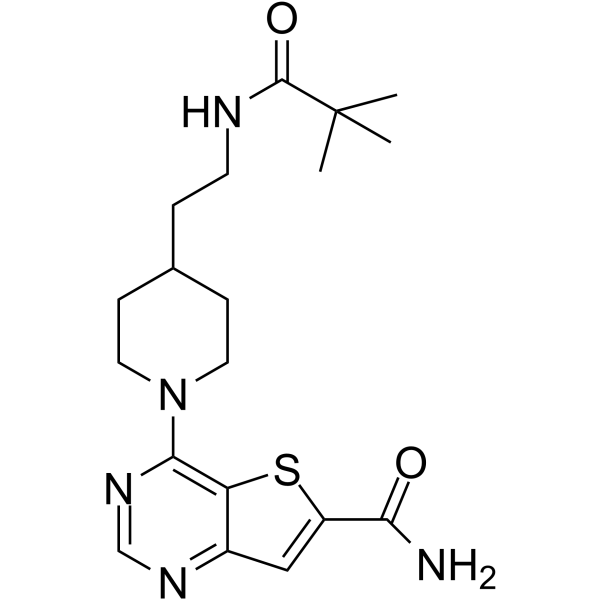
SIRT-IN-1
CAS No. 1431411-60-7
SIRT-IN-1( —— )
Catalog No. M26447 CAS No. 1431411-60-7
SIRT-IN-1 is a potent SIRT1/2/3 inhibitor(IC50s of 15, 10, 33 μM, respectively).
Purity : >98% (HPLC)
 COA
COA
 Datasheet
Datasheet
 HNMR
HNMR
 HPLC
HPLC
 MSDS
MSDS
 Handing Instructions
Handing Instructions
| Size | Price / USD | Stock | Quantity |
| 5MG | 177 | Get Quote |


|
| 10MG | 295 | Get Quote |


|
| 25MG | 502 | Get Quote |


|
| 50MG | 709 | Get Quote |


|
| 100MG | 1008 | Get Quote |


|
| 500MG | 2007 | Get Quote |


|
| 1G | Get Quote | Get Quote |


|
Biological Information
-
Product NameSIRT-IN-1
-
NoteResearch use only, not for human use.
-
Brief DescriptionSIRT-IN-1 is a potent SIRT1/2/3 inhibitor(IC50s of 15, 10, 33 μM, respectively).
-
DescriptionSIRT-IN-1 is a potent SIRT1/2/3 inhibitor(IC50s of 15, 10, 33 μM, respectively).(In Vitro):SIRT-IN-1 is one of the most potent inhibitor of truncated pan SIRT1/ 2/3(IC50 values are 0.015, 0.010, 0.033 μM, respectively). SIRT-IN-1 binds identically in the catalytic active site (RMS=0.29 ?), occupying the nicotinamide C-pocket and acetyl lysine substrate channel.
-
In VitroSIRT-IN-1 (compound 28) is one of the most potent truncated pan SIRT1/ 2/3 inhibitor, the IC50 values are 0.015, 0.010, 0.033 μM, respectively. SIRT-IN-1 (SIRT1/2/3 pan inhibitor) binds identically in the catalytic active site (RMS=0.29 ?), occupying the nicotinamide C-pocket and acetyl lysine substrate channel.
-
In Vivo——
-
Synonyms——
-
PathwayChromatin/Epigenetic
-
TargetSirtuin
-
RecptorKRas G12C
-
Research Area——
-
Indication——
Chemical Information
-
CAS Number1431411-60-7
-
Formula Weight389.52
-
Molecular FormulaC19H27N5O2S
-
Purity>98% (HPLC)
-
SolubilityIn Vitro:?DMSO : 19.23 mg/mL (49.37 mM)
-
SMILESCC(C)(C)C(=O)NCCC1CCN(CC1)c1ncnc2cc(sc12)C(N)=O
-
Chemical Name——
Shipping & Storage Information
-
Storage(-20℃)
-
ShippingWith Ice Pack
-
Stability≥ 2 years
Reference
1.Shin Y, et al. Discovery of N-(1-Acryloylazetidin-3-yl)-2-(1H-indol-1-yl)acetamides as Covalent Inhibitors of KRASG12C. ACS Med Chem Lett. 2019 Aug 20;10(9):1302-1308.
molnova catalog



related products
-
SIRT7 inhibitor 9749...
SIRT7 inhibitor 97491 is an HDAC inhibitor with high specificity for SIRT7 (IC50 = 325 nM). SIRT7 inhibitor 97491 promotes apoptosis through caspase pathway.
-
BPTES
BPTES(IC50 of 0.16 μM) is an effective and specific GlutamiN/Ase GLS1 (KGA) inhibitor.
-
SRT 1720
A potent, selective SIRT1 activator with EC1.5 of 0.16 uM.



 Cart
Cart
 sales@molnova.com
sales@molnova.com


